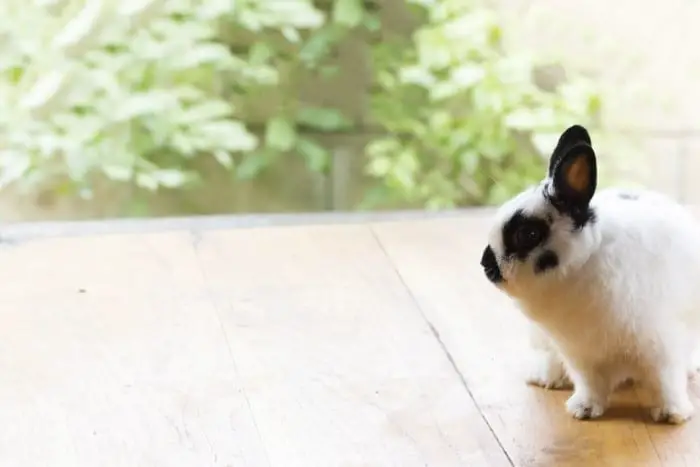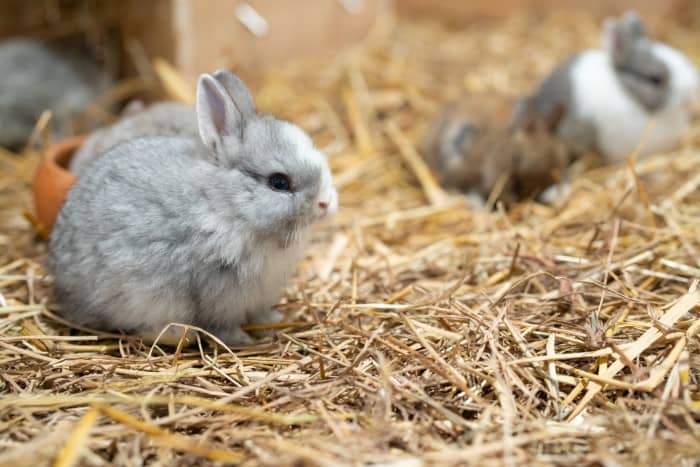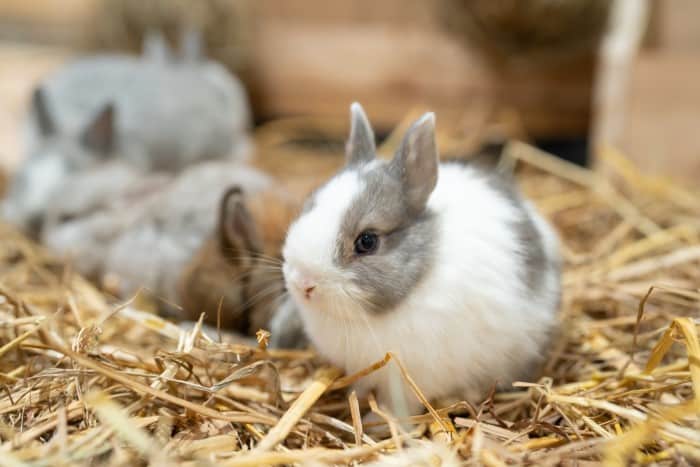Today we are going to explore the world of one of the most popular breeds of rabbits. And why is it so popular? Because it is the smallest breed of all. It is time to learn how to care for a Netherland Dwarf rabbit.
This small mammal makes an excellent company for those who want to have a docile and loving pet, which is also easy to care of due to its small size.
Suppose you are think of acquiring or adopting one of these adorable animals; you must understand their needs and what things you should consider giving them excellent quality of life.
What Are the Origins of This Breed?
Let us start by knowing a little about the origin of this peculiar breed. Although its name would indicate that these rabbits come from the Netherlands, its origins date back to 1880 from Dutch rabbits’ breeding in England.
Its origin was a consequence of a mutation in a recessive gene which provokes dwarfism. Many breeders noticed some kits were born smaller within their litters, and they decided to cross them to produce a new breed.
Breeders decided to export the new breed to Germany. After several other crosses with wild rabbits, they created a new standard that would later be exported to Holland.
Their breeding had to face significant challenges with the advent of World War II, so English breeders decided to export Rex rabbits to help the Dutch breeders. In 1949 the first club of the Dutch Dwarf was born in England, and in 1950, this breed was officially recognized by the most prestigious association in England.
How Is Their Temperament?
Dutch Dwarf rabbits characterize by being curious and extremely active rabbits, despite being such a small breed. They are very affectionate and playful rabbits.
Females are more independent, needing, at times, their own space. Males, on the contrary, are much more friendly and always seek human contact.
These bunnies are smart, and they are effortless to train and learn tricks quickly.
Physical Characteristics
Netherland Dwarfs are the smallest breed that exists. Perhaps their great popularity is because, even as adults, they maintain babylike features. Their weight ranges from 900 grams to 1kg.
These lovely bunnies characterize as having big eyes and tiny ears. They also have a broad chest and legs. These rabbits have compact, rounded bodies, large heads, short necks, and flat muzzles.
Netherland Dwarf rabbits are available in a wide range of beautiful colors. They can have long or short hair and live from 8 to 10 years, although some can live up to 14 years.

How to Care for a Dutch Dwarf Rabbit?
Taking care of the Dutch dwarf rabbit requires similar attention as you would give to any other rabbit. However, because it is such a small breed, it is usually a little more delicate, so you must take care of your dwarf rabbit well to keep it as healthy as possible.
Adapting to a New Environment
When you bring a rabbit home for the first time, you should try to offer them adequate space and a calm atmosphere as possible. You should avoid disturbing them and making loud noises so that their adaptation process is more manageable and does not expose them to stress.
In the beginning, the bunny may be frightened and try to hide, so you must be patient. You can offer your pet rabbit food as a means of encouragement and gradually offer your caresses, but never force them. With time your rabbit will learn to associate you with something good, and you will gain its confidence.
Feeding a Netherland Dwarf Rabbit
Netherland Dwarf rabbits are herbivorous animals and have a delicate digestive system. For all these reasons, it is imperative to offer them a balanced diet and the necessary quantities to avoid overweight and diarrhea. Always keep in mind the following recommendations:
- The types of combined food are fundamental as some can ferment in the digestive tract and generate diarrhea. Therefore, foods that are high in cellulose and low in sugars, starch, and fats are more recommendable.
- Approximately 80% of the menu must be hay, recommended to have it permanently within reach. The remaining percentage of the daily ration is covered with special feed for rabbits or pellets and fresh vegetables in smaller quantities. You can offer certain fruit types 1 to 2 times a week in minimal amounts or only as a prize.
- Always provide the right quantity of hay. Hay is an indispensable element in the diet of Netherland Dwarf rabbits as it helps them digest, avoids undesirable hairballs, and keeps their teeth in good condition.
- You can also include some juicy vegetables, that is, veggies containing some water but with a lot of fiber. You should not offer vegetables with a lot of water as they could cause diarrhea. Diarrhea can be very dangerous in these small animals because they can become dehydrated quickly.
Do not forget to provide fresh water throughout the day to prevent dehydration. Always have some clean, fresh water available.
Caring for Their Furs
It is advisable to brush our rabbits at least once a week, especially during the molting season. This way, you will help them avoid knots and ingest excess hair that forms hairballs in their stomach.
Short-haired rabbits can be brushed with a soft brush made of natural bristles. You can use a special metal brush or comb on long-haired rabbits. Remember that the rabbits’ skin is too delicate, so brushing should always be done with great delicacy and care.
On the other hand, these rabbits should not bathe as sudden changes in temperature can lead to severe problems and cause the animal to go into a state of shock. If they accumulate some secretion or dirt in the genital or anal region, you can clean it with a towel humidified in warm water or cotton soaked in oil.
Care of Teeth and Nails
This breed is more prone to dental disease due to the small size of their heads and shortened jaws. Owners of Netherland Dwarfs should be aware of the growth of their pets’ teeth and nails to prevent them from overgrowing. In this case, we recommend that you take your pet to the vet so that he can examine it and carry out the appropriate care.
In addition to feeding them hay, you can provide natural materials that they can gnaw on. Many gnawing toys are available in pet stores made from 100% natural and suitable ingredients, which will help your bunny file its teeth down, preventing them from growing too much.

How to Prepare the Cage for a Netherland Dwarf Rabbit
There are many points to consider when configuring an appropriate habitat for a Netherland Dwarf. Size and location are two main concerns in the care of these dwarf rabbits but complying with a cleaning program is also very important.
- Location: If you are going to keep your rabbit in a cage, the first thing to consider is its location. The pen should be placed in a bright and airy place but not exposed to air currents, direct sun, or near a heat source. These rabbits are very susceptible to air drafts and heatstroke, so it is not acceptable to leave them outside the house.
- Size: Despite being small animals, these bunnies need adequate space to live. It would be nice to place them in a cage with walkways and bridges so that they can run around and play, but if, due to space problems, you cannot offer this possibility, bear in mind that the measurements of the cage which houses your small pet should be a minimum of 90 cm long by 50 cm wide and 50 cm high. Remember that you must allow them to leave the cage several times a day to stretch and run around, always under supervision. Avoid leaving them unsupervised outside your house, as they are so small that they become easy prey for other predatory animals. It is necessary to consider that keeping an animal like this 24 hours a day and every day in a cage is inadequate and will make it suffer unnecessarily.
- Cleaning: To keep the cage clean, you can put in a corner a special tray for your pet rabbit to carry out its needs, far from the area where it sleeps and eats, like in opposite corners. Change the cage’s bedding frequently to prevent moisture and bacteria from growing and affecting your pet’s health. Clean the cage thoroughly every month with non-harmful products such as natural soaps, vinegar, etc.
The cage’s bottom should be stable. Make sure you cover it with adequate materials to avoid hurting its little paws. You may use wooden pellets, straw, and hay for this purpose. Avoid pine and cedar shavings as the aroma of these woods can be fatal for the rabbits.
Vaccination and Deworming
It is advisable to pay regular visits to the vet to keep your pet’s vaccinations up to date and deworm it periodically. Many pet owners downplay the importance of vaccinations. The risk to which the animal is exposed should always be assessed according to the area where it lives. Perhaps, a rabbit that lives safely in the city is not exposed to illnesses as a rabbit that lives in the country. Still, some diseases can be transmitted by vectors such as mosquitoes, so vaccination is the safest way to keep them healthy.
It is also an excellent recommendation to deworm the rabbits every six months, both for internal worms and external mites and fleas.
Do not be fooled by its small size. Netherland Dwarf rabbits are usually adorable pets and can make great companions just like any other bunny. However, their compact body is often their greatest vulnerability. For this reason, you should make extra effort to care for and protect them. Surely your care, love, and attention will provide them with a long and happy life.

